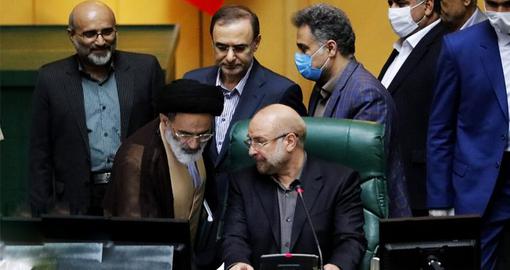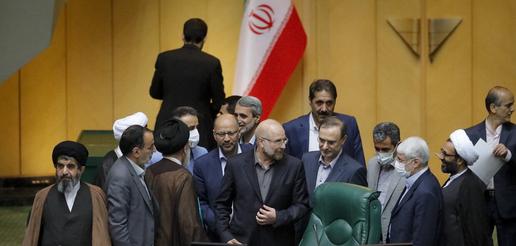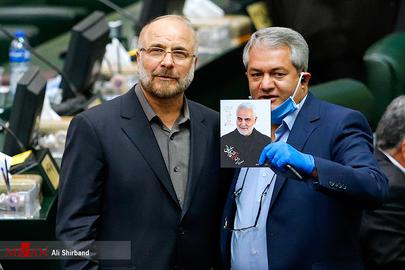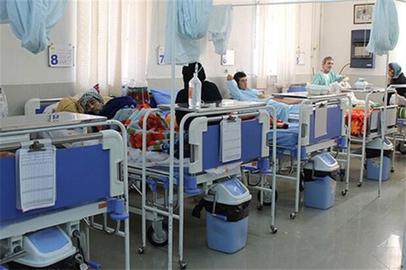Mohammad Bagher Ghalibaf, the former mayor of Tehran and Revolutionary Guards commander known for his links to some of Iran’s worst corruption scandals, has been appointed as Speaker of the Parliament, replacing Ali Larijani, who had been in the post since 2008.
In the 2017 presidential election, Ghalibaf, who was at the time mayor of Tehran, stood against against Hassan Rouhani and hardline conservative Ebrahim Raeesi and lost. Now, as the speaker of the parliament, he heads one of the three branches of government, alongside President Rouhani and Raeesi, who is now head of the judiciary.
In how many democracies does one see three presidential competitors leading the three branches of government?
Ghalibaf, who lost the last two presidential elections, won the most votes for Tehran in February’s parliamentary elections — an election that saw about 80 percent of eligible voters choosing not to go to the polls. Ghalibaf was elected after Hamid Reza Haji-Babaei, a five-term member of parliament from Tehran and a tough candidate, dropped out of the race for unknown reasons and left the field open for Ghalibaf to be elected.
The current parliament, the Islamic Republic’s 11th, has 290 members, and Ghalibaf was elected to be speaker by 230 votes, despite the fact that initially a faction loyal to former president Mahmoud Ahmadinejad and the principlist hardliner Islamic Resistance Front party, each with about 60 votes, had both expressed their opposition. Nevertheless, when it came to voting, he was elected, which could have been the result of outside intervention from powerful forces, especially the Revolutionary Guards and the office of the Supreme Leader.
The number of votes Ghalibaf received show that independents and the few reformists that exist in the 11th parliament supported his candidacy to chair the parliament, which was predictable because the two political groups are closer in their thinking to Ghalibaf’s supporters, who are on the moderate end of Iran’s conservative political tribe. If they were to enter into a coalition, they would do so with Ghalibaf supporters rather than the Islamic Resistance Front or supporters of Ahmadinejad.
Iran’s 11th Parliament and the Economy
It is no secret that Iran’s economy is in a terrible state. And yet, the new parliament is a cause for even more concern regarding the economy. A glance at the economic records of parliamentarians suggests that there are opportunities for even further damage and destruction to be done.
If this were anywhere except Iran, an individual like Mohammad Bagher Ghalibaf would be serving time for corruption, a great deal of which took place during his time as Tehran mayor. And even if he were acquitted of corruption, he would have been held accountable for destroying Tehran’s economy and for depriving the city’s future of its financial resources. But since this is the Islamic Republic, Ghalibaf has not been tried and has not been held accountable. Instead, he has been promoted to the head of the legislative branch.
“I am the representative and the voice of the 96 percent who are faced with the capitalist four percent,” Ghalibaf has said of his role as a public servant. And yet, the financial gains he made during his time in public office suggests he is on the opposite side of this divide.
As the speaker of the parliament, Ghalibaf is now a member of the Council of the Heads of Government Branches, a body that operates outside the stipulations of the constitution to decide about the most important economic issues facing Iran. So he is in a position that extends beyond his legislative power with the power to make decisions about sensitive issues including the price of gas, cash subsidies, the government budget, currency resources, the National Development Fund, and foreign trade, among other important matters.
During the construction boom of Ghalibaf’s time as mayor, many Iranians lost everything they had, but a considerable number of individuals made huge fortunes thanks to the economic chaos he created. Of course, the mayor was not the only person responsible for this chaos and corruption. He was simply building on what had been created by his fellow parliamentarians. Individuals such as Shamseddin Hosseini and Ali Nikzad, ministers of the economy and urban development under President Mahmoud Ahmadinejad, played important roles in pushing the Iranian economy into the pit of commercial housing development. The destructive development policies forged under President Ahmadinejad, and specifically the Mehr Housing Project, will go down in Iranian history, remembered as projects and policies that contributed hugely to one of the greatest contemporary economic crises.
Tenants were the biggest losers in the housing development project, but eventually this economic chaos turned into a full-fledged economic crisis and plunged the whole country into recession and a period of inflation. At the same time, one group of lucky people managed to upgrade their humble abodes to several apartment units. Commercial developers also did well, with their capital continuously multiplying in the stormy housing market. Municipalities benefited too, with huge amounts of money being plunged into their coffers.
Now Ghalibaf and Ahmadinejad’s associates sit in the parliament. The situation is somewhat different than when they were running Tehran and the country. The economy is under such pressure that the kind of deals they once did would not be possible today. And members of the parliament lack executive power. Regardless, these politicians have tools at their disposal to make the crisis even worse. Both Ghalibaf and former officials under Ahmadinejad currently sitting in parliament are known for their reckless and extreme management style that some refer to as “jihadi management.” Iran’s current fragile economy has much more to lose with these people at the helm.
Who is Mohammad Bagher Ghalibaf?
Mohammad Bagher Ghalibaf was born in 1961 in Torghabeh, 28 kilometers from the holy city of Mashhad. Prior to becoming speaker of the parliament, he taught geopolitics at Tehran University and was a member of the Expediency Council, a body whose members are appointed by the Supreme Leader to resolve differences between the parliament and the constitutional watchdog the Guardian Council.
But Ghalibaf’s record goes way back. During the 1980-88 war between Iran and Iraq, he rose quickly through the ranks. He was appointed as a commander when he was just 19, was the commander of the Imam Reza Brigade at 21 and the commander of Khorasan Nasr Division at 22. For Ghalibaf, war was a ladder to success. After the war he remained in the Revolutionary Guards and in 1994 was appointed as head of Khatam al-Anbia Construction Headquarters, an arm of the Revolutionary Guards that receives most of the contracts for lucrative development projects in Iran.
Just three years later, the Supreme Leader appointed him as the commander of the Guards’ Air Force. Then, from 2000 to 2004, he was the commander of the national police. In 2004 President Mohammad Khatami appointed him as the head of the Headquarters to Combat Goods and Currency Smuggling. There have been rumors that he used the money taken from smugglers to finance his presidential campaign in 2005.
After losing his presidential bid in 2005, he served as mayor of Tehran until 2013. During his tenure and afterwards, there have been numerous reports of his links to corruption, and his friends and members of his family have also been linked to corrupt deals. In one case in 2016, Yashar Soltani, editor-in-chief of Memari (“Architecture”) News, was arrested after his website revealed that more than 200 properties and pieces of land in northern Tehran were sold at a 50 percent discount to associates of Ghalibaf. Given that there are individuals within the Iranian judiciary who are likely to either be complicit in these deals or who are allies of Ghalibaf, the cases of corruption against him have never led to any serious prosecutions and even a parliamentary investigation into an “astronomical” corruption scandal simply fizzled out. He was neither punished nor was deterred from continuing his corrupt practices.
In 2017 Ghalibaf again ran for president and was again defeated. After that he did not engage in any specific political activities for a while, but on December 7, 2019, the last day that candidates could register, Ghalibaf made a big show of putting himself forward for the February 2020 parliamentary elections. Iranian state TV covered his visit to the Interior Ministry to register, a move that was criticized in parliament.
Ghalibaf’s Record as Mayor of Tehran
Ghalibaf was mayor of Tehran for 12 years. During these years, there was more construction in the city and the municipality itself had the biggest revenue stream in the entire history of the capital.
For decades, Tehran has faced a range of different challenges, including class divisions, corruption, housing, and the looming danger of earthquakes. As the top executive officer of the city for 12 years, Ghalibaf had enough time to make a difference. But what does his record actually look like?
The Class Divide
As the mayor of Tehran, Ghalibaf could have made a palpable difference in healing class divisions in Iran’s capital and its suburbs. The divide between affluent northern Tehran and its poverty-stricken south goes back decades, at least to the 1960s. However, urban development experts believe that Tehran’s municipality could have reduced this class divide by expanding public transportation services between the north and the south and by changing its approach toward its sources of revenue.
But as Ghalibaf’s record shows, despite Tehran municipality’s exorbitant budgets during his tenure, he was less interested in building transportation infrastructure between central and northern Tehran and its southern and marginal areas and chose to concentrate on building flashy highways, mega malls and residential towers in northern, northeastern and northwestern Tehran on land that mostly belonged to the Revolutionary Guards. Examples include the two-level elevated Sadr Expressway in northeastern Tehran, the artificial Chitgar Lake in northwestern Tehran, the creation of which ushered in a whole host of environmental problems, residential towers around this lake and the Iran Mall complex, other mega malls such as Kurosh and Palladium Shopping Center, extensive construction in the hills of Abbas Abad in the north and the repurposing of gardens and green spaces in northern Tehran for real estate development.
By contrast, during his 12 years in office, when he had ample budget at his disposal, just 30 kilometers were added to the metro serving the nation’s capital and its close neighbor Karaj.
Ghalibaf prides himself for creating Tehran’s Bus Rapid Transit (BRT) system but it has remained limited to two bus lines, from north to south and from east to west, and not only did these two lines not solve the problem of bus overcrowding, but they added to the traffic jams during rush hours.
The class divide in Tehran was not helped by the sale of so-called “density” permits, permits to build high-rises and mega malls. Many urban planners advocate these developments because they operate more efficiently when residents live in denser urban surroundings, but they can and do create problems if they are carried out without foresight. Some permits under Ghalibaf were sold legally, but there were also large amounts of illegal development too. Some of these permits allowed building on land that residents had used for social gatherings and exercise, such as parks or recreational centers, contributing to what is known as “spatial inequality.”
The “dense” development in northern Tehran closed the “wind corridors” to central and southern Tehran that helped improve the quality of air in those areas. Closing those corridors has hurt the health and quality of life of the residents of southern Tehran and, in the absence of an adequate healthcare system, helped perpetuate poverty in these neighborhoods.
Under Ghalibaf, Tehran municipality spent five times more on religious propaganda and promoting the values of the Islamic revolution than on protecting and improving the environment.
Urban Problems: Housing, Traffic, Over-development
Under Ghalibaf, traffic congestion and air pollution in Tehran reached a critical point, and this has continued over the last four years since his departure. These problems are the direct results of the urban development that took place during his years in office, particularly the over-development of northern Tehran. These issues also feed into the ongoing problem of the class divide, not least because there has not been ample provision of public transport.
Despite the construction of many expressways in northern Tehran, a number of highways that connect the densely populated areas of central and southern Tehran to the area present serious traffic problems in rush hours, made worse by the concentration of commercial centers and offices in the north. Other highways that connect Tehran to nearby cities like Karaj suffer from the same problem.
Ghalibaf’s management, of course, was not the only factor in the increase of air pollution in Tehran and surrounding towns, but his incompetence was a main contributing factor. Through its sales of “density” permits, its support of developers of residential high rises in northern Tehran and by allowing building on green spaces, Tehran municipality under Ghalibaf directly contributed to the increase of air pollution in Iran’s capital.
Corruption
Ghalibaf’s name has become a synonym for corruption. Corruption cases during his tenure as mayor are among the biggest in the history of the Islamic Republic and, unfortunately, neither Ghalibaf nor his accomplices have been held accountable. One of them, as mentioned above, was the “astronomical” land-deal corruption scandal that was exposed by Memari News. It was the editor in chief of the website who paid the price by getting arrested, not Ghalibaf or his associates. Memari News reported on August 27, 2016, that it had acquired documents revealing that 1,100,000 square meters of government-owned property, including apartments and villas, had ended up in the possession of various individuals, including government officials, sometimes sold at a 50 percent discount. All in all, this swindle was said to be worth more than $700 million, a truly astronomical figure for Iran.
The next corruption case involving Ghalibaf and his associates was revealed by Mohammad Ali Najafi, Ghalibaf’s successor as Tehran mayor. A hundred days after taking over from Ghalibaf in August 2017, Najafi submitted a report to Tehran City Council that revealed that 1.43 billion tomans, over $540,000, were embezzled to pay for Ghalibaf’s presidential campaign in 2017. Ghalibaf had signed a contract with an affiliate company of the national police that was worth only 10 million tomans, a little over $3,000, but the municipality paid the affiliate company 1.43 billion tomans and, a short while later, that company deposited the money into the account of the head of Ghalibaf’s presidential campaign.
Ghalibaf’s wife and son were also involved in corruption. On April 21, 2014 Iranian media reported that Elias Ghalibaf, the mayor’s son who was also Tehran Municipality’s media advisor, had been arrested for financial misdeeds in connection with an educational institute by the name of Shams al-Shamus. He was held in custody for 24 hours. Reports on the matter were later removed from news sites after Tehran Municipality denied them and Mohammad Bagher Ghalibaf claimed that his son was merely a “teacher.” Zahra Moshir, Ghalibaf’s wife, was accused of first-degree corruption, as set out in an article about a corruption case involving the Imam Reza Charitable Institution published in November 2017 by Shargh newspaper. As with many other cases of corruption, it ended up getting nowhere.
It was also reported that by forgoing annual audits during Ghalibaf’s tenure, Tehran municipality is in debt for 52 trillion tomans, close to $3.5 billion. Because there was no audit, nobody knows where the money has gone.
Social Ills
The underdeveloped public transportation system, dark streets and alleyways and the increase in the number of pedestrian bridges instead of street crossings have played a direct role in the rise of social ills such as the harassment of women in the streets. Life was also made more difficult for women in Tehran when Ghalibaf was mayor because of the expenditure of huge amounts of money on religious and sometimes misogynistic propaganda instead of trying to promote a culture that encourages social participation by women.
One of Iran’s most devastating social issues is child labor. Like many other Islamic Republic politicians, Ghalibaf exploited this issue for political purposes but, in practice, not only did he not take any action to help children, he made the situation worse by closing down organizations that supported them and by forcing these children to live in even worse poverty. For instance, in the waning days of Ghalibaf’s tenure, the Society for the Defense of Child Laborers and Street Children, a non-government organization that had helped these children, including by promoting their education, for 10 years was shut down in the spring of 2017 after a long period of threats from Tehran municipality and security agencies.
Instead, with the cooperation of the City Council’s Social Affairs Committee, Tehran municipality engaged in numerous inhumane projects such as the “collection of child laborers.” The main function of such projects was to dehumanize child laborers and to present them as objects controlled by the panhandling mafia, whereas many of these children were not panhandlers and worked as individuals to provide for themselves and for their needy families.
Under Ghalibaf, Tehran municipality followed a similar approach toward street vendors. By helping the housing mafia instead of working to reduce class divisions and increase social justice, the municipality increased the cost of living in Tehran and even in its margins to such a degree that many could not afford it and had to resort to street vending.
Tehran’s construction boom under Ghalibaf did nothing to help those who had been left behind when it came to home ownership. According to housing statistics for the years 2006 to 2016, around seven million housing units were constructed and the Mehr Housing Project made up close to two million of this number. But, instead of helping people to become homeowners, the tenant population of Iran doubled over those 10 years.
Earthquakes
Tehran and the cities around it are located in an earthquake-prone zone. Ghalibaf could have played a major role in making the city better protected from earthquakes but even his multi-billion dollar projects such as Tohid Tunnel and the Sadr elevated expressway are not earthquake-safe. It is said that the expressway is built on the same engineering principles as the Kobe bridge that fell down in the magnitude 9 earthquake that hit Japan in 2011.
Under Ghalibaf, many permits were issued to build residential towers over active fault lines in Tehran and this considerably increases the risk of damage and fatalities as a result of an earthquake.
Although some experts believe that buildings in Tehran are not badly vulnerable to earthquakes, the high density of population around narrow streets and alleys as a direct result of the policies of selling “density” permits could lead to millions of deaths if and when an earthquake causes panic that could drive people to trample each other to death to reach the safety of open spaces.
Ghalibaf’s Plans and the Problems of his Constituents
Ghalibaf must be more familiar with Tehran’s problems than anybody else. Therefore, the programs that he announced for his electoral district matched the problems of his constituents to a large extent. But the real question is this: considering his long record of ignoring Tehran’s most fundamental problems, does he have the will to address these problems, some of which he created when he was mayor? “The parliament must be accountable to the people and be part of them. Members of the parliament must be the people's representatives, not their masters," Ghalibaf has said, but it’s difficult to know how his time as mayor of Tehran will have equipped him to take on such a role.
For the moment, the media pays more attention to his campaign propaganda than to his practical plans. With the slogan of “neo-principlism,” Ghalibaf has been trying to win the support of young principlist conservatives, and it was this support that won him the speakership of the parliament. Of course, it is not clear that he will be able to count on the support of traditional hardliner principlists or supporters of Mahmoud Ahmadinejad.
In his presidential campaign in 2017, Ghalibaf focused more on poverty and the class divide. By bringing up the populist catch phrase of “4% vs. 96%”, meaning the rich versus the rest of the Iranian population, he tried to present himself as a man of the people, but nobody trusted him . Can this former mayor of Tehran use the speakership of the parliament to prove that he is one of the people and use his position as a launch pad for the presidency? It is too soon to say.
visit the accountability section
In this section of Iran Wire, you can contact the officials and launch your campaign for various problems



























comments